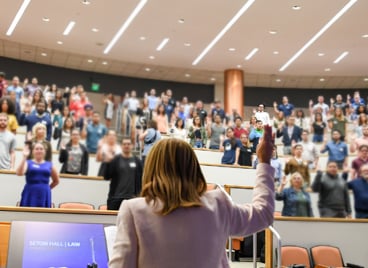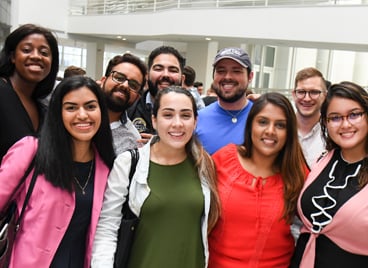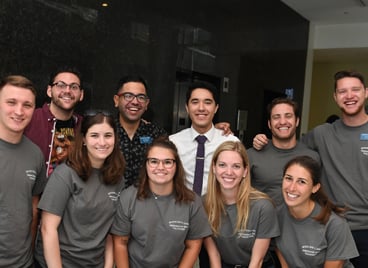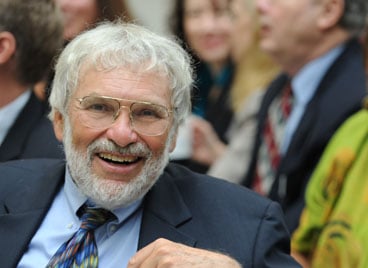Press Release
For media inquiries, contact Brian Sheppard at [email protected] or 973-642-8583. Press Releases available here.
Seton Hall Law Report Reveals Guantanamo was Developed with a Dual Objective, Ultimately Placing Lawful Detention of POWs in Conflict with Experimental Interrogation Practices
Major General Michael E. Dunlavey ‘directed’ by President George W. Bush, built an intelligence-gathering operation outside the standard chain of command; formalized the abuse of detainees. He and successors referred to GTMO as ‘America’s Battle Lab’
Newark, New Jersey - The Seton Hall Law Center for Policy & Research released its latest report, “Guantanamo: America’s Battle Lab.” This report reveals the extent to which the camp at Guantanamo Bay, Cuba, created on the surface to detain prisoners of the Global War on Terror in compliance with the Geneva Conventions, was actually secretly structured and maintained as a site for conducting unlawful experiments on detainees with a goal less to gather intelligence from the victims than to develop techniques to be used around the world.
“The Senate report detailing the numerous abuses of Guantanamo prisoners reveals the cruelty and incompetence of the Central Intelligence Agency. But it only scratches the surface,” said Professor Mark P. Denbeaux, Center Director. “Our research demonstrates that Guantanamo housed a well-organized, systematic multi-agency effort to engage in experimentation and seek new ways to extract information through torture. FBI agents frequently reported physical and psychological abuse of detainees that were personally offensive to the agents, yet their reports went unheeded. As the FBI reports indicated, and the Senate report confirmed, none of these 'experiments’ yielded any useful information to defend the U.S. in the War on Terror.”
The report includes the following points:
- Under Executive Order Joint Task Force (JTF)-160, in January 2002 Brigadier General Rick Baccus built GTMO as a detention center for Prisoners of War, in compliance with the Geneva Conventions.
- Under Executive Order JTF-170, issued in March 2002, Major General Michael E. Dunlavey built a system of intelligence gathering at GTMO which did not report through the standard chain of command. Rather, General Dunlavey reported in-person each week to Secretary of Defense Donald Rumsfeld. Dunlavey: “I got my marching orders from the President of the United States.”
- The contingent conducting “Intel,” included the Defense Intelligence Agency, the Joint Intelligence Group, civilian contractors, special operations, psychological operations (PSYOPs), a Behavioral Science Consultation Team (BSCT) and special access programs (SAPs).
- Once General Dunlavey took command of the intelligence-gathering operation, he immediately sought to maximize the effectiveness of GTMO’s Intel efforts. Colonel Stuart Herrington, a retired Army intelligence officer, advised that Intel must be in “full control of the detainees’ environment.”
- In the months that followed, tensions arose between the team implementing JTF-160 and Intel as it rolled out JTF-170. By October 2002, Intel was holding meetings to discuss both how to instill “controlled chaos” in the camp, meaning techniques designed to play on phobias – “insects, snakes, [and] claustrophobia.”
- The officers also planned how to avoid notice of their activities by outside authorities. Lieutenant Colonel Diane E. Beaver, quoted at a meeting: “We may need to curb the harsher operations when ICRC [International Committee of the Red Cross] is around. It is better not to expose them to any controversial techniques.”
- On October 9, 2002, General Baccus was relieved of his post and the two strains of camp management – detention and intelligence – became more fully coordinated under subsequent leaders, with the intelligence-gathering mission taking the lead.
“America’s Battle Lab,” which chronicles the shift in command and focus of Guantanamo and how it led to the systematic abuse of detainees, is the culmination of the Center’s efforts to understand the circumstances under which three detainees died at Guantanamo in 2006, allegedly by suicide. Previous reports include “Death in Camp Delta” and “Uncovering the Cover Ups,” which follow the trail of eyewitness accounts, retracted statements and legislators’ fruitless attempts to determine the facts of the detainees’ deaths. An eyewitness account and the Center’s subsequent research have been further detailed in Murder at Camp Delta (Simon & Schuster, January 20, 2015), by Sergeant Joseph Hickman, who was stationed at Guantanamo the night the detainees died.
“In multiple reports, our Research Fellows pulled back the curtain on the alleged suicides of the three GTMO detainees,” Professor Denbeaux explained. “They untangled the web of confusing and contradictory statements of witnesses and investigators and demonstrated that the deaths of the detainees could not logically have been self-inflicted. We asked at the time, why are so many government agencies working so hard to hide the facts about what happened that night at Guantanamo? Taken in the context of the Senate report and our findings in ‘America’s Battle Lab,’ we have an answer. Guantanamo's secrets were far worse than anyone had imagined, involving high-ranking generals, the Secretary of Defense, and if the generals are to be believed, the President of the United States.”
Seton Hall University School of Law, New Jersey's only private law school, and a leading law school in the New York metropolitan area, is dedicated to preparing students for the practice of law through excellence in scholarship and teaching, with a strong focus on clinical education. "Guantanamo: America’s Battle Lab” is the Seton Hall Law Center for Policy & Research's 24th Guantanamo Report. Since 2006, Center reports have been introduced into the Congressional Record by the Senate Armed Services Committee, the Senate Judiciary Committee, the House Armed Services Committee, and as part of a Resolution by the European Parliament. The Guantanamo reports have also been cited by media throughout the world. The report may be found at law.shu.edu/battlelab.
Contacts:
Janet LeMonnier
Executive Director, Communications
Office: 973-642-8583
Cell: 973-985-3165
Email: [email protected]
Professor Mark P. Denbeaux
Director, Seton Hall Law Center for
Office: 973-642-8822
Cell:
Email: [email protected]
January 12, 2015





